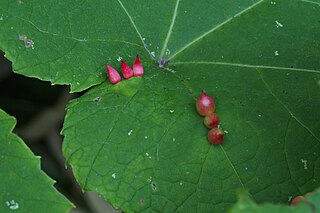
A midge is any small fly, including species in several families of non-mosquito Nematoceran Diptera. Midges are found on practically every land area outside permanently arid deserts and the frigid zones. Some midges, such as many Phlebotominae and Simuliidae, are vectors of various diseases. Many others play useful roles as prey for insectivores, such as various frogs and swallows. Others are important as detritivores, and form part of various nutrient cycles. The habits of midges vary greatly from species to species, though within any particular family, midges commonly have similar ecological roles.

Casuarina, also known as Australian pine and native pine, is a genus of flowering plants in the family Casuarinaceae, and is native to Australia, the Indian subcontinent, Southeast Asia, islands of the western Pacific Ocean, and eastern Africa.

Cecidomyiidae is a family of flies known as gall midges or gall gnats. As the name implies, the larvae of most gall midges feed within plant tissue, creating abnormal plant growths called galls. Cecidomyiidae are very fragile small insects usually only 2–3 mm (0.079–0.118 in) in length; many are less than 1 mm (0.039 in) long. They are characterised by hairy wings, unusual in the order Diptera, and have long antennae. Some Cecidomyiids are also known for the strange phenomenon of paedogenesis in which the larval stage reproduces without maturing first. In some species, the daughter larvae consume the mother, while in others, reproduction occurs later on in the egg or pupa.
Daphnephila ornithocephala is a species of gall midge first associated with leaf galls on Lauraceae species, particularly Machilus thunbergii in Taiwan. Based on analysis on sequences of the mitochondrial cytochrome c oxidase subunit I, it has been suggested that in this genus, the stem-galling habit is a more ancestral state as opposed to the leaf-galling habit. This genus appears to have originated tropically and dispersed to Japan through Taiwan.

A gnat is any of many species of tiny flying insects in the dipterid suborder Nematocera, especially those in the families Mycetophilidae, Anisopodidae and Sciaridae. They can be both biting and non-biting. Most often they fly in large numbers, called clouds. "Gnat" is a loose descriptive category rather than a phylogenetic or other technical term, so there is no scientific consensus on what constitutes a gnat. Some entomologists consider only non-biting flies to be gnats. Certain universities and institutes also distinguish eye gnats: the Smithsonian Institution describes them as "non-biting flies, no bigger than a few grains of salt, ... attracted to fluids secreted by your eyes".

Asphondylia is a cosmopolitan genus of gall midges in the family Cecidomyiidae. All species in this genus induce galls on plants, especially on flowers and flower buds. There are over 300 described species in Asphondylia, with many more likely to be discovered and described, especially in the southern hemisphere.

Rhopalomyia is a genus of gall midges, insects in the family Cecidomyiidae. There are at least 267 described species in Rhopalomyia. Most species in this genus induce galls on plants in the Asteraceae. This genus has a cosmopolitan distribution. Rhopalomyia was first established by Ewald Heinrich Rübsaamen in 1892.
Catotricha is a genus of midges in the family Cecidomyiidae. The five described species in Catotricha are found in the holarctic region. This genus was established by British entomologist Frederick Wallace Edwards in 1938.

Ampelomyia vitiscoryloides, the grape filbert gall midge, is a species of gall midge in the family Cecidomyiidae. It induces galls on grape plants and is widespread in eastern North America. It was first described by Alpheus Spring Packard in 1869.
Amedia is a genus of wood midges in the family Cecidomyiidae. The only described species - Amedia floridana - is only known from Florida. The genus was established by Mathias Jaschhof in 1997.
Daphnephila is a genus of gall midge that appears in the Palearctic and Oriental biogeographic realms. Daphnephila species create leaf and stem galls on species of laurel plants, particularly in Machilus. Based on analysis on sequences of the mitochondrial cytochrome c oxidase subunit I, it has been suggested that in this genus, the stem-galling habit is a more ancestral state as opposed to the leaf-galling habit.
Ampelomyia is a genus of gall midges in the tribe Asphondyliini. It consists of the following four species, all of which form galls on grape plants:
Anabremia is a genus of gall midge in the family Cecidomyiidae. The six described species are found in the Palearctic and likely inquilines of Dasineura galls on plants in the legume family. This genus was first described by Jean-Jacques Kieffer in 1912.
Massalongia is a genus of flies in the family Cecidomyiidae. The larvae induce galls on birches.
Trichoceromyia is a genus of midges in the family Cecidomyiidae. There is one described species in this genus: Trichoceromyia oregonensis. It is only known from Oregon.
Allaretella is a genus of midges in the family Cecidomyiidae. Allartella germanica is the only described species in this genus. It has been recorded in Sweden, Latvia, Germany, and Austria. The genus was first described by Hans Meyer and Voldemars Spungis in 1994.
Antennardia is a genus of midges in the family Cecidomyiidae. The four described species are found in the Holarctic realm. The genus was first described by Boris Mamaev in 1993, but was subsequently treated as a subgenus of Monardia until being reinstated at the genus level.
Berestella is a genus of wood midges in the family Cecidomyiidae. The only described species - Berestella insuperabilis - is only known from Rovno amber from the Late Eocene. The genus was established in 2007 and named for Ukrainian entomologist Zoya L. Berest.

Ampelomyia conicocoricis is a species of fly in the family Cecidomyiidae. It induces galls on grape plants in Japan. This is the type species for the genus.







